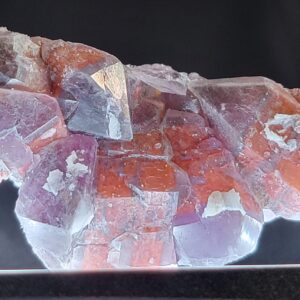Description
Diamonds have a hardness of 10 and a specific gravity of 3.5. The first known use of their name is by Manlius in 16AD and then again by Pliny in 100AD, according to Mindat, the Greek “adamas” for ‘invincible’. According to Wikipedia, “The name diamond is derived from Ancient Greek: ἀδάμας (adámas), ‘proper, unalterable, unbreakable, untamed’… Ancient Greek: δαμάω (damáō), ‘to overpower, tame’.”
Also from Wikipeida, “Diamonds are thought to have been first recognized and mined in India, where significant alluvial deposits of the stone could be found many centuries ago along the rivers Penner, Krishna, and Godavari. Diamonds have been known in India for at least 3,000 years but most likely 6,000 years.”
While Diamonds today have a complicated history and convoluted economic value, made further complicated by the Ukraine-Russia conflict, you can be sure that these Diamonds do not benefit any foreign country or entity and are the real deal – straight from Colorado!
Other than the locality from which these came, there are an additional 21 known recorded localities within Colorado alone, and around 132 in the US. Globally, there’s nearly 1,000 known localities recorded on every continent. So, no matter where you are, be sure to keep an eye out for an indestructible rock like these!
Being 100% Carbon and having been once Graphite that’s since been compressed and heated beyond comprehension, these are now an expensive and perfect sample and representation for Carbon. In addition to Coal and Graphite, Diamonds are the most well-known natural representation of Carbon, but despite being small, these are definitely the coolest!!
The following is taken from Wikipedia:
The Kelsey Lake Diamond Mine is now a defunct diamond mine in Colorado. It is located in the State Line Kimberlite District, near the Wyoming border, and consists of nine kimberlite volcanic pipes, of which two were open pit mined. At the time it was operating, it was the United States’ only modern diamond mine, and only the second commercial diamond mining operation in North America.
Ever since diamonds had first been found in the State Line Kimberlite District in ’76, interest had been high in locating a viable commercial mining operation. Geologist Howard Coopersmith headed the Diamond Company L.N. which explored the feasibility of mining diamonds at the Kelsey Lake site. In’ 95 Australian firm Redaurum acquired controlling interest in Diamond Co. and proceeded to lease mining rights for the land around Kelsey Lake. Commercial output started in ’96. After mining and selling approximately 200 carats worth of diamonds, Redaurum was sued by Union Pacific who had originally sold the land in 1896 but claimed that it held on to the mineral rights. The two parties settled the lawsuit but in ’97 Redaurum decided to liquidate its diamond properties to concentrate on exploration.
The mine was operated sporadically until the operation was acquired by McKenzie Bay International Ltd. in ’00, then the mine ceased operations in ’01, and the site was fully reclaimed by ’06.
Of the nine volcanic pipes found, three were reported to contain diamonds, and two were mined. These two pipes are each approximately 10.5 acres in area, are at least 350 feet deep, and are situated 0.5 mi apart. Bulk sampling during exploration in ’90 and ’91 recovered grades of 3.4 to 4.5 cts per hundred tons for diamonds larger than 2 millimetres (0.079 in). Of the diamonds recovered, 50-65% were gem quality, and 25-30% of those were 1 ct or larger.
While Redaurum ran the operation, the mine ran at half-capacity and produced almost 12,000 carats in ’96 and 9,000 carats in ’97. When McKenzie Bay first acquired the mine, they estimated that each of the two pipes being mined had about 340,000 carats worth of gems and could be profitably mined for about 10 years. The previous owners had a marketing agreement with local Denver diamond dealers to sell them Kelsey Lake diamonds for $115 per carat. If production had risen to the expected levels of 60,000 carats per year, McKenzie Bay expected to make $6.9 million annually. However, with the rising prices of vanadium McKenzie Bay shifted their focus away from Kelsey Lake and began mine reclamation procedures in 2003.
In ’94, a 14.2-ct, gem-quality white diamond was recovered, at the time it was the sixth-largest diamond ever found in North America and was described as “almost flawless”, estimated to be worth $250,000. Then, in ’96, the largest diamond found at the mine was discovered. Named the “Colorado Diamond,” the 28.3-ct yellow stone was then the fifth-largest diamond found in North America. That gem was cut and polished by legendary New York diamond cutter Bill Goldberg which yielded a 5.39-ct faceted stone that sold for $87,500.












Reviews
There are no reviews yet.